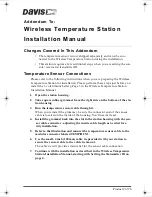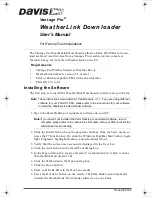
6.7.4.1 Example radio configuration and power usage
Configuration of base radio at the computer:
l
Multi-Point Master
l
RS-232 @ 115,200 bps (Use 9600 bps baud rate for non Campbell Scientific software if
needed)
l
Network ID: 1234
l
Frequency Key: 5
l
1 Watt Output (Transmit Power: 10)
Weather station radio:
l
Multi-Point Slave
l
Communication with Data logger via CS I/O SDC7
l
Network ID: 1234
l
Frequency Key: 5
l
1 Watt Output (Transmit Power: 10)
l
Low Power Mode: 2
See your spread spectrum radio manual for changing radio settings.
Power usage examples:
Polling the station once every 10 minutes and staying on line with the station for one minute
consumes approximately 1.276 amps over a 24-hour period. If the station were to lose power, it
could run for around 4.3 days (105 hours) before damaging the battery. A station with a 10-watt
panel would need at least three hours of sunlight every day to keep the battery charged.
Recommendation here would be to decrease the power output of the radios or add a PS24
power supply and enclosure with a 24 amp-hour battery below the main enclosure. See
Ah power supply with 10 x 12 inch enclosure
(p. 83) for mounting options and information on the
PS24.
Polling the station once an hour and staying on line with the station for one minute consumes
approximately 0.388 amps over a 24-hour period. If the station were to lose power, it could run
for around 14 days (346 hours) before damaging the battery. A station with a 10-watt panel
would need at least one hour of sunlight every day to keep the battery charged.
6.7.4.2 Internal installation of the radio
NOTE:
If the T107 was ordered with a radio kit, skip this section and go directly to
Section 6. Installation
42
















































